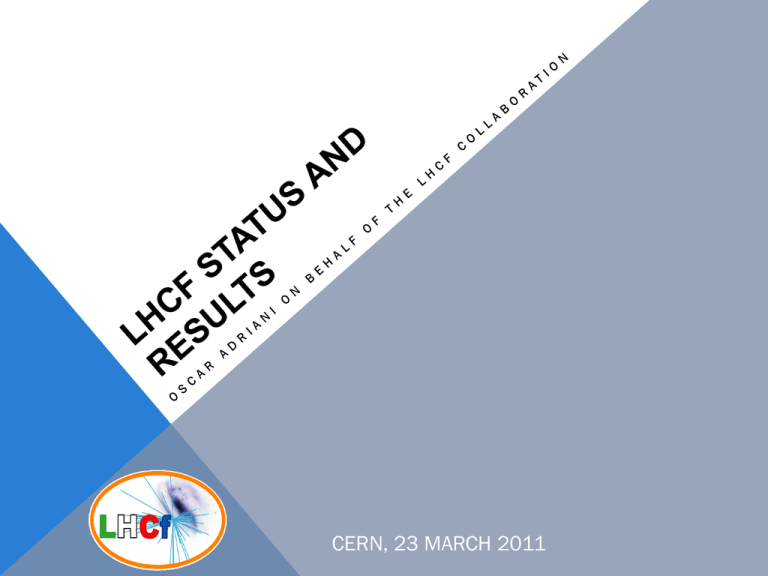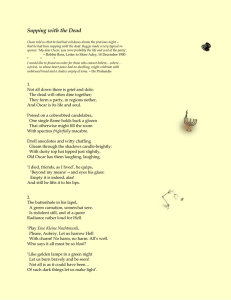LHCf status and results
advertisement

CERN, 23 MARCH 2011 HECR OPEN ISSUES M Nagano New Journal of Physics 11 (2009) 065012 AGASA x 0.9 AUGER x 1.3 Difference in the energy scale between different experiments??? Different hadronic interaction models give different answers about the composition of HECR The depth of the maximum of the shower Xmax depends on energy and type of the primary particle OSCAR ADRIANI LHCC MEET ING, CERN 23 MA RCH 2011 LHCF EXPERIMENTAL SET-UP Detectors installed in the TAN region, 140 m away from ATLAS Interaction Point (IP1) Here the beam pipe splits in 2 separate tubes. Charged particle are swept away by magnets We will cover |h|>8 Protons Charged particles Neutral particles Front Counters: thin scintillators with 8x8cm2 acceptance installed in front of each main detector OSCAR ADRIANI Beam pipe LHCC MEET ING, CERN 23 MA RCH 2011 4 pairs of scintillating fiber ARM1 & ARM2 DETECTORS layers for tracking purpose (6, 10, 32, 38 r.l.) Impact point (h) Arm#2 4 pairs of silicon microstrip layers (6, 12, 30, 42 r.l.) for tracking purpose (X and Y directions) Absorber 22 tungsten layers 7– 14 mm thick (2-4 r.l.) (W: X0 = 3.5mm, RM = 9mm) Arm#1 Energy OSCAR ADRIANI 16 scintillator layers (3 mm thick) Trigger and energy profile measurements LHCC MEET ING, CERN 23 MA RCH 2011 OSCAR ADRIANI LHCC MEET ING, CERN 2 3 MA RCH 2 011 LHCF OPERATIONS @900 GEV & 7 TEV th th With Stable Beam at 900 GeV Dec 6 – Dec 15 2009 With Stable Beam at 900 GeV May 2nd – May 27th 2010 Shower Gamma Hadron Arm1 46,800 4,100 11,527 Arm2 66,700 6,158 26,094 With Stable Beam at 7 TeV March 30th - July 19th We took data with and without 100 μrad crossing angle for different vertical detector positions Shower Gamma Hadron Arm1 172,263,255 56,846,874 111,971,115 344,526 Arm2 160,587,306 52,993,810 104,381,748 676,157 OSCAR ADRIANI LHCC MEET ING, CERN 23 MA RCH 2011 DATA SET FOR INCLUSIVE PHOTON SPECTRUM ANALYSIS • Data –Date : 15 May 2010 17:45-21:23 (Fill Number : 1104) except runs during the luminosity scan. –Luminosity : (6.5-6.3)x1028cm-2s-1, –DAQ Live Time : 85.7% for Arm1, 67.0% for Arm2 –Integrated Luminosity : 0.68 nb-1 for Arm1, 0.53nb-1 for Arm2 –Number of triggers : 2,916,496 events for Arm1 3,072,691 events for Arm2 –Detectors in nominal positions and Normal Gain • Monte Carlo –QGSJET II-03, DPMJET 3.04, SYBILL 2.1, EPOS 1.99 and PYTHIA8.145: about 107 pp inelastic collisions each OSCAR ADRIANI LHCC MEET ING, CERN 23 MA RCH 2011 1 TEV p0 CANDIDATE EVENT Longitudinal profile A p0 candidate event 599GeV gamma-ray and 419GeV gamma-ray in 25mm and 32mm tower respectively. Transverse profile OSCAR ADRIANI LHCC MEET ING, CERN 23 MA RCH 2011 LUMINOSITY ESTIMATION Luminosity for the analysis is calculated from Front Counter rates: L = CF ´ RFC The conversion factor CF is estimated from luminosity measured during Van der Meer scan I1I2 LVDM = n b f rev 2ps xs y VDM scan Beam sizes sx and sy measured directly by LHCf BCNWG paper https://lpc-afs.web.cern.ch/lpcafs/tmp/note1_v4_lines.pdf OSCAR ADRIANI LHCC MEET ING, CERN 23 MA RCH 2011 OSCAR ADRIANI LHCC MEET ING, CERN 2 3 MA RCH 2 011 Particle Identification PID criteria based on transition curve 500 GeV <EREC<1 TeV MC/Data comparison done in many energy bins •QGSJET2-gamma and -hadron are normalized to data(/collision) independently • LPM effects are switched on OSCAR ADRIANI LHCC MEET ING, CERN 23 MA RCH 2011 PID CORRECTION Efficiency and purity for gamma-ray estimated from L90% fitting with MC template (QGSJET2). Hatched : data Red : true-gamma Blue : true-hadron Green : Red+Blue Bin by bin (energy) correction applied to take into account shape disagreement between Data/MC (see systematic error section) OSCAR ADRIANI LHCC MEET ING, CERN 23 MA RCH 2011 OSCAR ADRIANI LHCC MEET ING, CERN 2 3 MA RCH 2 011 p0 MASS Arm1 Data • Disagreement in the peak position • No ‘hand made correction’ is applied for safety • Main source of systematic error see later Peak at 145.8 ± 0.1 MeV 7.8 % shift Many systematic checks have been done to understand the energy scale difference Arm2 Data Peak at 140.0 ± 0.1 MeV OSCAR ADRIANI Arm2 MC (QGSJET2) Peak at 135.0 ± 0.2 MeV 3.8 % shift LHCC MEET ING, CERN 23 MA RCH 2011 p0 MASS VS p0 ENERGY Arm2 Data No strong energy dependence of reconstructed mass OSCAR ADRIANI LHCC MEET ING, CERN 23 MA RCH 2011 h MASS Arm2 detector, all runs with zero crossing angle True h Mass: 547.9 MeV MC Reconstructed h Mass peak: 548.5 ± 1.0 MeV Data Reconstructed h Mass peak: 562.2 ± 1.8 MeV (2.6% shift) OSCAR ADRIANI LHCC MEET ING, CERN 23 MA RCH 2011 OSCAR ADRIANI LHCC MEET ING, CERN 2 3 MA RCH 2 011 MULTI-HIT REJECTION In order to extract inclusive single gamma spectra, rejection of multi-hit events is mandatory especially at high energy (> 2.5 TeV) OSCAR ADRIANI LHCC MEET ING, CERN 23 MA RCH 2011 MULTI-HIT REJECTION Multi-hit events are identified thanks to position sensitive layers in ARM1 (SciFi) and Arm2 (Si-mstrip) OSCAR ADRIANI LHCC MEET ING, CERN 23 MA RCH 2011 MULTI-HIT REJECTION Single gamma detection efficiency for various MC models Multi gamma detection efficiency for various MC models Please have a look to systematic error section! OSCAR ADRIANI LHCC MEET ING, CERN 23 MA RCH 2011 OSCAR ADRIANI LHCC MEET ING, CERN 2 3 MA RCH 2 011 ACCEPTANCE CUT We define in each tower a region common both to Arm1 and Arm2, to compare the Arm1 and Arm2 reconstructed spectra. Our final results will be two spectra, one for each acceptance region, obtained by properly weighting the Arm1 and Arm2 spectra R1 = 5mm R2-1 = 35mm R2-2 = 42mm q = 20o For Small Tower h > 10.94 For Large Tower 8.81 < h < 8.99 OSCAR ADRIANI LHCC MEET ING, CERN 23 MA RCH 2011 ARM1 AND ARM2 COMPARISON Multi-hit rejection and PID correction applied Energy scale systematic not considered due to strong correlation between Arm1 and Arm2 OSCAR ADRIANI Deviation in small tower: still unclear, but within systematic errors LHCC MEET ING, CERN 23 MA RCH 2011 COMBINED SPECTRA AND COMPARISON WITH MODELS Gray hatched: stat.+syst. error Blue hatched: QGSJET2 stat. error Arm1 and Arm2 combined spectra including syst. errors OSCAR ADRIANI LHCC MEET ING, CERN 23 MA RCH 2011 OSCAR ADRIANI LHCC MEET ING, CERN 2 3 MA RCH 2 011 SYSTEMATIC UNCERTAINTIES Uncorrelated uncertainties between ARM1 and ARM2 - Energy scale (except p0 error) Estimated for Arm1 and Arm2 - Beam center position by same methods but independently - PID Estimated by Arm2, and apply it to the both Arm - Multi-hit selection Correlated uncertainty - Energy scale (p0 error) - Luminosity error OSCAR ADRIANI LHCC MEET ING, CERN 23 MA RCH 2011 SYSTEMATIC ERROR FROM ENERGY SCALE Two components: - Relatively well known: Detector response, SPS => 3.5% - Unknown: p0 mass => 7.8%, 3.8% for Arm1 and Arm2. Please note: - 3.5% is symmetric around measured energy - 7.8% (3.8%) are asymmetric, because of the p0 mass shift - No ‘hand made’ correction is applied up to now for safety Total uncertainty is -9.8% / +1.8% for Arm1 -6.6% / +2.2% for Arm2 Systematic Uncertainty on Spectra is estimated from difference between normal spectra and energy shifted spectra. OSCAR ADRIANI LHCC MEET ING, CERN 23 MA RCH 2011 BEAM CENTER POSITION Error of beam center position is estimated to be 1 mm from comparison between our results and the BPM results The systematic errors on spectra were estimated from the difference between spectra with 1 mm shift of acceptance cut area. Arm1 Results (Small tower, true single-gamma) (Large tower, true single-gamma) Fluctuation in HE is probably statistical 100 GeV<E<3.5 TeV : 5% OSCAR ADRIANI 100 GeV<E<2.5 TeV : 10% E>2.5 TeV : 20% LHCC MEET ING, CERN 23 MA RCH 2011 SYSTEMATIC ERROR FROM PID Efficiency and purity are estimated with two different approaches Template fitting A: Template fitting B: 1 degree of freedom: 3 degrees of freedom: - Absolute normalization - Absolute normalization - Shift of L90% distribution - Width of L90% distribution Hatched : data Red : true-gamma Blue : true-hadron Green : Red+Blue Arm1 Systematic error from PID: 100GeV<E<1.7TeV : 5% 1.7TeV<E : 20% Both on small and large tower OSCAR ADRIANI LHCC MEET ING, CERN 23 MA RCH 2011 SYSTEMATIC ERROR FROM MH True/Reconstructed True/Reconstructed Systematic error is estimated from the deformation factor of original MC spectrum wrt reconstructed MC spectrum for various models OSCAR ADRIANI LHCC MEET ING, CERN 23 MA RCH 2011 CONCLUSIONS • LHCf Inclusive photon analysis has been completed • Many detailed systematic checks were necessary! • ‘Very safe’ estimation of systematics • First comparison of variuos hadronic interaction models with experimental data in the most challenging phase space region (8.81 < h < 8.99, h > 10.94) • Other analysis are in progress (hadrons, PT distributions, different h coverage etc.) • We are upgrading the detectors to improve their radiation hardness (GSO scintillators) • Discussion are under way to come back in the TAN for the possible p-Pb run in 2013 (LHCC, Alice, LHC, Atlas etc.) • We will anyway come back for the 14 TeV run with upgraded detector!!!! OSCAR ADRIANI LHCC MEET ING, CERN 23 MA RCH 2011 A SPECIAL THOUGHT FOR JAPAN OSCAR ADRIANI LHCC MEET ING, CERN 23 MA RCH 2011 OSCAR ADRIANI LHCC MEET ING, CERN 2 3 MA RCH 2 011 IMPACT OF LHCF ON CR PHYSICS Transition curve for 1017eV proton π0 reconstructed spectrum Xmax = 696.6g/cm2 ± 2.3 +15.9, -7.8 g/cm2 statistical systematic ⇔ΔXmax (DPMJETⅢ-QGSJETⅡ) = 36g/cm2 OSCAR ADRIANI LHCC MEET ING, CERN 23 MA RCH 2011 LUMINOSITY DURING THE VDM SCANS 26th April 2010 9th May 2010 Luminosity (/cm2s) FC1 5.90E+27 FC2 6.04E+27 FC1&2 5.99E+27 Luminosity (/cm2s) FC1 2.01E+28 FC2 2.00E+28 FC1&2 2.09E+28 Intensity information Fill 1059 (26th April) Fill 1089 (09th May) beam1 8.98±0.34 N(1) 10.20±0.38 N(17851) 18.99±0.54 N(1) 19.08±0.54 N(17851) beam2 10.35±0.37 N(1) 10.35±0.37 N(8911) 22.18±0.61 N(1) 21.21±0.59 N(8911) beam1*2 92.94 N(1) 421.20 N(1) OSCAR ADRIANI LHCC MEET ING, CERN 23 MA RCH 2011 LUMINOSITY ERRORS contents Intensity2 Difference between April scan & May scan error 5.0% 2.1% Difference between arm1&2 Total 2.7% 6.1% Total systematic uncertainty due to luminosity was estimated to be 6.1% OSCAR ADRIANI LHCC MEET ING, CERN 23 MA RCH 2011 ESTIMATION OF PILE UP When the circulated bunch is 1x1, the probability of N collisions per Xing is N l exp[-l] P(N) = N! L× s l= f rev The ratio of the pile up event is P(N ³ 2) 1- (1+ l )e- l Rpileup = = -l P(N ³1) 1- e The maximum luminosity per bunch during runs used for the analysis is 2.3x1028cm-2s-1 So the probability of pile up is estimated to be 7.2% with σ of 71.5mb Taking into account the calorimeter acceptance (~0.03) only 0.2% of events have multi-hit due to pile-up. It does not affect our results OSCAR ADRIANI LHCC MEET ING, CERN 23 MA RCH 2011 ENERGY RECONSTRUCTION AT SPS Difference of energy reconstruction at SPS between data and MC is < 1%. Systematic error for gain calibration factor layer by layer is 2% OSCAR ADRIANI LHCC MEET ING, CERN 23 MA RCH 2011 COMPARISON OF EJ260 AND GSO -PULSE SHAPE• Response for the N2 (Nitrogen) LASER • pulse width is ~300ps (fast enough) • EJ260 : ~12ns decay time GSO • GSO : 30~40ns decay time • Roughly similar decay time EJ260 OSCAR ADRIANI LHCC MEET ING, CERN 23 MA RCH 2011 COMPARISON OF EJ260 AND GSO -RADIATION HARDNESS• EJ260 (HIMAC* Carbon beam) 10% decrease of light yield after exposure of 100Gy • GSO (HIMAC Carbon beam) No decrease of light yield even after 7*10^5Gy exposure, BUT increase of light yield is confirmed • The increase depend on irradiation rate (~2.5%/[100Gy/hour]) *HIMAC : Heavy Ion Medical Accelerator in Chiba OSCAR ADRIANI LHCC MEET ING, CERN 23 MA RCH 2011 LINEARITY OF PMT R7400 • PMTs R7400 are used in current LHCf system • The test was held in HIMAC using Xe beam • PMT R7400 showed good linearity within 1% up to signal level corresponding to 6TeV showerMAX in LHCf. OSCAR ADRIANI LHCC MEET ING, CERN 23 MA RCH 2011





